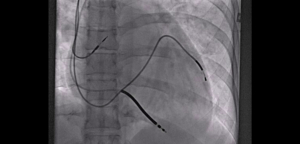Cardiac resynchronization therapy (CRT) treats some types of heart failure. Heart failure is a condition when the heart is not able to pump (contract itself) enough blood to the body.
When the heart is pumping blood, the left and right ventricles should do so at the same time (synchronous). In some patients with heart failure, the left ventricle does not squeeze blood at the same time (due to left bundle branch block), thus causing heart failure which is further worsen.
The CRT is a special device known as the biventricular stimulator. This device is very similar to a two electrode pacemaker, with an additional third electrode stimulating the left ventricle. CRT, just like the conventional pacemaker, sends electrical impulses thus synchronizing the operation of the left and right ventricle. In this way, it is possible to reduce the symptoms of heart failure in patients.
CRT is a device very similar to the pacemaker and consists of:
- pulse generator – a metal casing, in which a special battery and microcomputer are sealed.
- 3 electrodes, one of which is located in the right atrium, one in the right ventricle and one at the surface of the left ventricle (in coronary sinus).
Implantation of cardiac resynchronization therapy
The implantation procedure is the same as of a permanent pacemaker, only exception is that due to the complexity of the third electrode placing/implantation, the procedure can last longer (see permanent pacemaker implantation).
Depending on the type of heart disease, doctors may decide for a so-called combined device. This combined device has the ability for biventricular stimulation (cardiac resynchronization) and cardioverter defibrillator (ICD) ability (see Implantable Cardioverter Defibrillator).
Video: Implantation of cardiac resynchronization at Sisters of Mercy University Hospital Centre


 Aritmije KBCSM
Aritmije KBCSM Aritmije KBCSM
Aritmije KBCSM